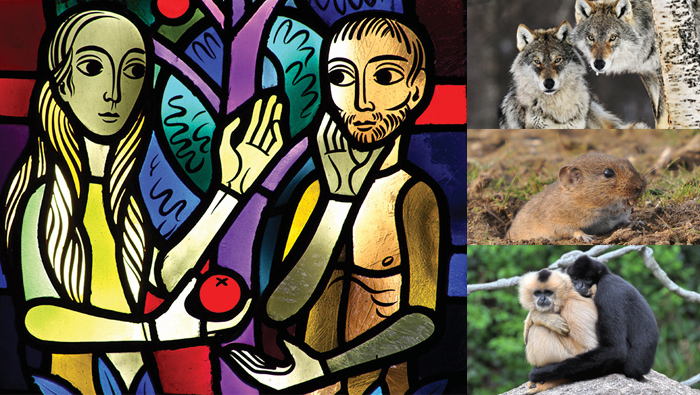The concept of mating for life comes from the earliest of couples, Adam and Eve. Since Eve was made from part of Adam, and made especially for him, the intention was for her to be his mate for life, thus becoming the first “married” couple. There were other biblical couples that shared the rites of marriage and stayed together for life: Abraham and Sarah, Isaac and Rebekah, Jacob and Rachel. While the intention of marriage is to “mate for life” often humans fall short in this endeavor. This concept got me thinking about mating for life outside of our realm and into the world of nature. You often hear of animals that mate for life, but which ones really do?
Love is for the birds
Swans come to mind as the ultimate symbol of love in the animal world. You’ll see them on greeting cards with their necks entwined in the shape of a heart. They form monogamous bonds and the male is even known to use his powerful wings to scare off would-be suitors during mating season. The pair do double duty feeding and caring for their newly hatched cygnets.
Eagles spend time alone but reunite with the same partner during the breeding season. The male and female take turns incubating the eggs then feeding the young chicks for the first few months after they hatch. Eagle mates will return to and refresh the same nest year after year.
The black vulture is at the opposite end of the bird spectrum as far as looks go. These raptors may actually be more loyal than their more-attractive counterparts. Bonded vultures will stay together year-round, even sharing food with other family members. It’s a good thing both parents are involved in the feeding and raising of the chicks, considering they don’t build a nest: The female lays her eggs directly on the ground in caves or other places that provide shelter.
The bonds these birds form isn’t nearly as romantic as we make them out to be. It’s really more a practical arrangement. How long it takes for birds to migrate, establish a home territory, then lay, incubate and raise their young cuts into valuable reproductive time. But a dependable mate takes the pressure off the female during mating season; and a bonded pair can “learn” from any previous breeding mistakes, leading to more positive outcomes for chicks and ensuring the survival of their species.
Mimicking humans behaving badly
Another species with a mating-for-life mantra is the prairie vole. With an average lifespan of only one to two years, it must breed as much as possible. The sparse grasslands of the U.S. and Canada offer limited resources for these rodents’ habitats. Prairie voles are models of monogamy, huddling together for warmth, grooming one another and sharing in pup-raising responsibilities. If male voles give any indication they may not stick around once the babies arrive, the females have been known to grab them by the scruff of the neck, as if to shake some sense into them. Sounds more like a human behavior!
Our closest “relative” that mates for life is the gibbon. But while these primates may appear to be monogamous, a 2013 study at Khao Yai National Park in Thailand found that as many as one in 10 baby gibbons is fathered by a male other than the female’s partner.
Still, gibbons form strong pairs, grooming and spending time together. Males and females are roughly the same size, giving the impression that they’re on equal footing. But they are also known to leave a mate on occasion – a more human-like trait.
Wolves and coyotes set the example
Gray wolves have a relationship comparable to humans, with a family life that consists of a male, female and their offspring. Other wolves may be welcomed into the pack, but the alpha couple are usually the only ones to breed, unless there is an abundant food supply to support the growth of the pack. A single pair breeding also avoids overpopulation.
The alpha male is the leader until the mating season, but the female picks the den location. While the pups are in the den, other members of the pack hunt for her and the hungry pups.
Another mostly monogamous canine is the coyote. A 2012 article by National Geographic suggests their monogamy could be the cause of their ability to thrive in urban environments.
Most canines practice social monogamy, but they tend to stray when times get tough. Not coyotes. Thanks to the ability to find food in urban areas, along with the help of male partners, females are having larger litters, thus ensuring a thriving coyote population.
Straying seahorses and testy termites.
The coyote female has a loyal mate, but the potbellied seahorse female must be much more selective when it comes to choosing the potential father of her children. Competition is fierce and the male – who carries the babies after birth – is devoted to that female’s offspring. However, research shows that when it comes time to mate again, the male seahorse may be led astray by another female larger than his current mate.
While mating may get complicated for the seahorse, things can get downright ugly for the termite. The termite queen often forms a lifelong bond with her “king” and they become the parents of their entire colony. But researchers at New York’s Cornell University discovered that pairs can get nasty if they decide to separate. They can become physically violent and may even chew off each others’ antennae.
The term “mate for life” is somewhat of a misnomer in the animal kingdom. If something happens to an animal’s mate, that animal will move on and seek another – like Harriet the eagle did. Humans also do this in the case of a divorce from or the death of a partner. All in all, this select group of animals and others like them who tend to be monogamous seem to have figured out the delicate balance of maintaining a relationship, building a home and raising children. Maybe the animal kingdom has a better handle on these things than we do – it appears that the divorce rate is much lower in the wild!






